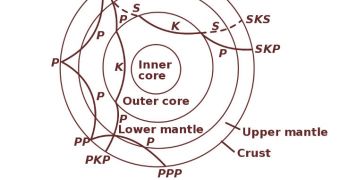A new research paper published in the latest issue of the esteemed journal Nature shows that lighter chemical elements such as sulfur and oxygen tend to gather at the edge of our planet's core. The data were derived following an ultrasound analysis-like study of Earth, experts say.
Seismology experts say that the finding could explain why our planet continues to produce a magnetic field 4.6 billion years after forming, as opposed to being dead from this point of view, as Mars is.
In fact, it could be that the study may provide additional insight into the way the planet itself formed. The study may also challenge some long-standing theories about how the planetary cores looks like.
At this point, most experts believe that Earth features a solid inner core, which is surrounded by a liquid outer core, some 7,000 kilometers in diameter.
This theory is based on the thorough study of seismic waves, shock waves of sort that develop as earthquakes pass in close proximity to the core. The speed of the waves has been used for many years as a way of establishing the density of the planet's center.
These investigations have shown that the density found at the core is similar to that or iron, but not identical, as University of Bristols seismologist points out in the new study George Helffrich.
“There's been a feeling that there's a light element in addition to iron that makes the core less dense,” the expert explains, adding that the general view among scientists is that the element(s) may in fact be contaminants left over from when the planet first formed.
Together with Kyushu University planetary scientist Satoshi Kaneshima – also the coauthor of the Nature paper – Helffrich conducted measurements during three earthquakes. The seismic wave detectors were placed on the opposite side of the planet to where the tremors' epicenters were.
A South America quake was observed from Japan, and two similar event in Fiji, the South Pacific, were observed from Europe. These vantage points allowed for the collection of data that indicated in great detail how the waves acted when passing by the core.
The main result of the work was finding out that the outermost 300 kilometers of the core are nowhere near as dense as the rest. Helffrich says that 3 to 5 percent of the outer shell on the core may be made up of sulfur and oxygen.
As the inner core becomes solid, the lightest chemicals are pushed outwards. The UB expert proposes that this chemical reaction is also underlying the dynamo effect of the core, which drives Earth's magnetosphere, our main defense against solar radiation.
The process through which oxygen and sulfur are released into the outer core “releases a huge amount of gravitational potential energy,” the researcher adds, quoted by Nature News.

 14 DAY TRIAL //
14 DAY TRIAL //